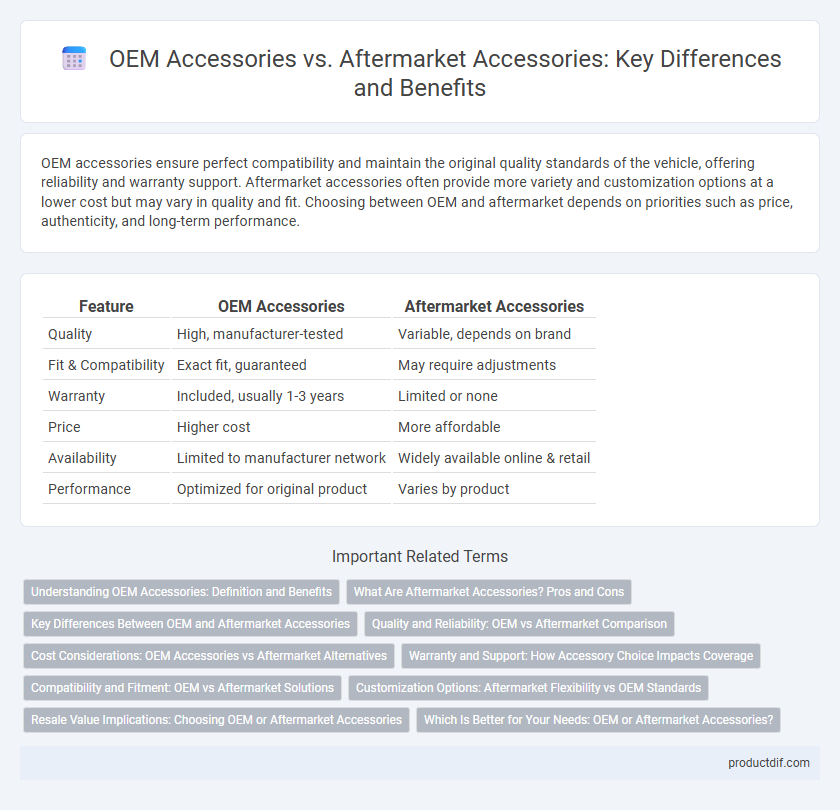OEM accessories ensure perfect compatibility and maintain the original quality standards of the vehicle, offering reliability and warranty support. Aftermarket accessories often provide more variety and customization options at a lower cost but may vary in quality and fit. Choosing between OEM and aftermarket depends on priorities such as price, authenticity, and long-term performance.
Table of Comparison
| Feature | OEM Accessories | Aftermarket Accessories |
|---|---|---|
| Quality | High, manufacturer-tested | Variable, depends on brand |
| Fit & Compatibility | Exact fit, guaranteed | May require adjustments |
| Warranty | Included, usually 1-3 years | Limited or none |
| Price | Higher cost | More affordable |
| Availability | Limited to manufacturer network | Widely available online & retail |
| Performance | Optimized for original product | Varies by product |
Understanding OEM Accessories: Definition and Benefits
OEM accessories, or Original Equipment Manufacturer accessories, are products made by the same company that produced the original vehicle, ensuring perfect compatibility and quality. These accessories are designed to meet strict manufacturer standards, offering enhanced reliability, safety, and warranty protection compared to aftermarket alternatives. Choosing OEM accessories helps maintain vehicle value and performance by preserving factory specifications and optimal integration with existing systems.
What Are Aftermarket Accessories? Pros and Cons
Aftermarket accessories are non-OEM parts produced by third-party companies designed to fit and function as alternatives to original manufacturer accessories. They often offer greater variety, lower prices, and customization options but may vary in quality, fit, and durability compared to OEM counterparts. Consumers should weigh these factors, considering warranty implications and compatibility issues before purchase.
Key Differences Between OEM and Aftermarket Accessories
OEM accessories are manufactured by the original equipment maker, ensuring exact fit, compatibility, and quality standards specific to the vehicle model. Aftermarket accessories, produced by third-party companies, offer a wider variety of choices and often come at a lower price but may vary in quality and fit. Key differences between OEM and aftermarket accessories include warranty coverage, material quality, and long-term durability, with OEM parts generally providing better reliability and optimal performance.
Quality and Reliability: OEM vs Aftermarket Comparison
OEM accessories are engineered to meet exact manufacturer specifications, ensuring optimal quality and seamless compatibility with the original product. Aftermarket accessories vary significantly in quality, often lacking rigorous testing and certification, which can lead to inconsistent performance and reduced reliability. Choosing OEM guarantees durability and warranty support, whereas aftermarket options may offer cost savings but carry higher risks of malfunction or premature wear.
Cost Considerations: OEM Accessories vs Aftermarket Alternatives
OEM accessories typically come with higher upfront costs due to brand assurance, quality control, and warranty coverage, ensuring compatibility and longevity. Aftermarket accessories offer more budget-friendly options and a wider variety but may vary significantly in quality and durability, potentially leading to additional expenses over time. Evaluating total cost of ownership, including installation and replacement frequency, is crucial when choosing between OEM and aftermarket accessories.
Warranty and Support: How Accessory Choice Impacts Coverage
OEM accessories typically offer comprehensive warranty coverage directly from the manufacturer, ensuring compatibility and reliable support tailored to the original product. Aftermarket accessories, while often more affordable, may lack equivalent warranty protection and can potentially void the primary product's warranty if not approved. Selecting OEM accessories maximizes warranty benefits and access to authorized customer service, minimizing risks related to accessory failure or product damage.
Compatibility and Fitment: OEM vs Aftermarket Solutions
OEM accessories are specifically designed and tested by the original manufacturer to ensure perfect compatibility and fitment with the vehicle's make and model, maintaining factory standards. Aftermarket accessories may offer a wider range of styles and price points but often vary in quality, leading to potential issues with fitment and compatibility that can affect performance and safety. Choosing OEM guarantees consistent integration, while aftermarket options require careful evaluation to avoid mismatches or installation challenges.
Customization Options: Aftermarket Flexibility vs OEM Standards
Aftermarket accessories offer greater customization options, allowing users to tailor products to specific preferences beyond the limitations set by OEM standards. OEM accessories ensure precise compatibility and maintain manufacturer quality but often lack the variety found in aftermarket solutions. Choosing aftermarket parts provides flexibility in design, materials, and features, catering to niche demands that OEM offerings may not address.
Resale Value Implications: Choosing OEM or Aftermarket Accessories
OEM accessories maintain higher resale value due to guaranteed compatibility, quality, and manufacturer warranty support, appealing to buyers who prioritize original equipment standards. Aftermarket accessories may lower resale value because of varied quality and potential fitment issues, but offer cost savings and customization options that can attract niche markets. Prioritizing OEM accessories enhances vehicle appeal in resale markets, while aftermarket choices require careful selection to avoid depreciating value.
Which Is Better for Your Needs: OEM or Aftermarket Accessories?
OEM accessories guarantee compatibility and maintain the original quality standards set by the vehicle manufacturer, ensuring optimal performance and warranty compliance. Aftermarket accessories often offer a wider variety of styles and price points, but quality can vary significantly and may impact vehicle functionality. Choosing between OEM and aftermarket accessories depends on priorities like budget, customization, and assurance of durability.
OEM accessories vs aftermarket accessories Infographic

 productdif.com
productdif.com